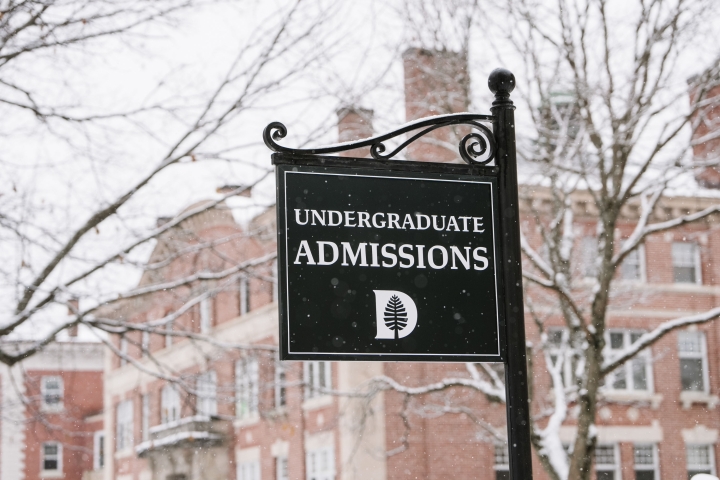The number of applications for the first cohort of the Class of 2029 matched last year’s record pace as Dartmouth received 3,550 applications for early decision, marking the College’s sixth early record pool since 2017.
The first offers of admission to the incoming class were extended to students Dec. 13, when early decision results were released. The deadline for regular admissions is Jan. 2, with those decisions to be released on March 27.
And in the first year of early decision admissions since Dartmouth led the Ivy League in choosing to reinstate testing, 95% of those offered early admission on Friday have an SAT or ACT score at or above the 75th-percentile of test-takers at their high school.
“We consider test scores in the context of the applicant’s school and community and the environmental factors associated with that location,” says Lee Coffin, vice president and dean of admissions and financial aid. “Local counts, that’s how we read each file. ”
The pool of applicants for the Class of 2029 represents a 71% increase in early decision applicants since Dartmouth last required testing in 2019. In June 2020, during the COVID-19 pandemic, the testing requirement was suspended as many students were not able to take the SAT and ACT exams.
When ranked, 98% of the applicants offered admission are ranked within the top 10% of their senior class, with a record 22% ranked as their school’s projected valedictorian or salutatorian.
This fall, 1,470 high-achieving, low-income students applied via the College Match Program of QuestBridge, the national access organization that partners with many of the nation’s most selective colleges and universities. That pool was seven applicants shy of last year’s record high.
“Our sustained volume in the early rounds is remarkable, and it was unexpected,” Coffin says. “In 30 years as a senior admission officer, I have never seen two consecutive pools line up as closely as this year’s early decision and QuestBridge pools did with last year’s record volume.”
Beginning this year, Dartmouth will join several of its peer institutions in releasing admissions data during the active admissions cycle that does not include how many students were offered admission, or the admission acceptance rate, as a way to de-emphasize the stress of Ivy League selectivity, says Kathryn Bezella, Dartmouth’s new assistant vice president and dean of undergraduate admissions.

“Our admissions process is anchored in thoughtful, holistic review. We consider each student within their own, individual context, so when we celebrate our admitted students at this important moment, it seems reductive to boil their talents, ambitions, intellectual curiosity, and vision for joining our community down to an acceptance rate,” she says.
Students accepted via early decision and QuestBridge represent 48 U.S. states and the District of Columbia, as well as 44 countries, with 16% living outside the United States.
Continuing a recent trend, 45% of those living in the United States reside in either the South or West as the geographic axis of Dartmouth’s undergraduate admission profile solidifies in these fast-growing regions. California, Texas, and Florida represent three of the top five states, and 44% live in New England and the Mid-Atlantic region.
“I will remember these applicants for the rest of my career,” says Bezella, reflecting on her first selection process at Dartmouth. “Their vivid writing, the specificity of their reasons for choosing us, the insights they offered about their own lives and perspectives—it was a pleasure to get to know them through this process, and it is exciting to be signing their acceptance letters this week.”
“The thoroughness with which we review files is one of the many aspects of Dartmouth’s approach that makes me proud to have joined this team,” she added.
Dartmouth’s ongoing investment in need-based financial aid continues to enhance the demographic profile of the incoming class. The preliminary average scholarship for the early cohorts is a record $73,000, and 25% qualified for a financial aid package without a parental contribution.
Due to ongoing delays with the Free Application for Federal Student Aid, aka FAFSA, the number of Pell Grant recipients is unconfirmed at this time, but Dino Koff, assistant vice president and executive director of financial aid, predicts a strong cohort that aligns with last year’s early result.
Some 18% are first-generation college bound, 56% attend a public or charter high school, 10% attend a school that enrolls 50% or fewer of its graduates to a four-year college. In the first year since Dartmouth joined the Students from Rural and Small Towns partnership, 15% have a rural background. Eleven percent are the child of a Dartmouth graduate, and a quarter of all legacy acceptances have two Dartmouth parents.
